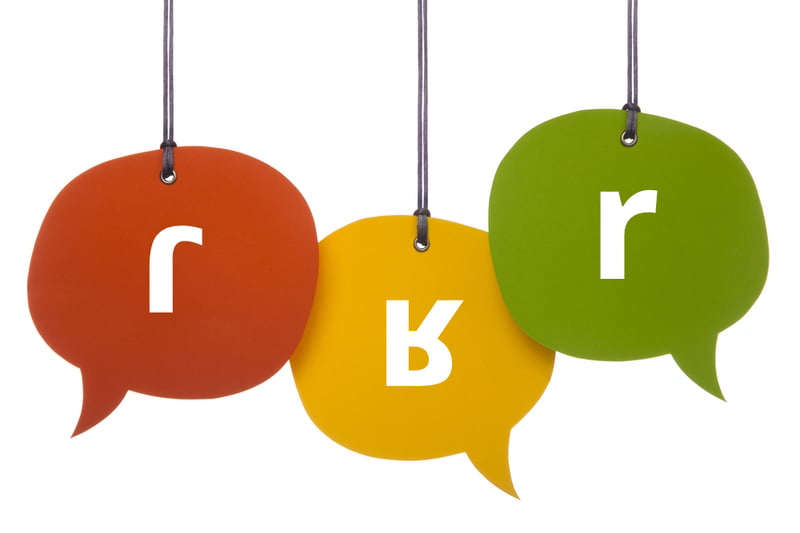The Portuguese R is one of the more difficult sounds to master. We covered it briefly in our Pronunciation Guide to European Portuguese Consonants, but it deserves a bit more explanation!
Pronunciation varies across different Portuguese dialects, so you will likely hear variations in the the R (as well as other sounds). We’ll focus on the “standard” Lisbon pronunciation here for simplicity’s sake. Just keep in mind that you may hear it differently in other parts of Portugal, and especially in Brazil.
First we’ll describe how the English R is pronounced, so that you can differentiate it from the many pronunciations of the Portuguese R. Then we’ll talk about the primary R pronunciations in European Portuguese: flap R, guttural R, and trill R.
🏴☠️ The English R
Arrr, matey! The most obvious way to reveal yourself as an English speaker in Portugal is to use the so-called “English R”, i.e. the [ɹ] or [ɻ] pronunciation, in Portuguese words. This is sometimes known as the retroflex R. It is not present in Portuguese, or most other languages, for that matter.
There are a few variations for pronouncing an English R (plus some variations among dialects, of course), but in general, the sides of the tongue pull back against the teeth and the tongue tip curls up toward the alveolar ridge (the part of the roof of your mouth that is right behind your teeth), approaching it, but not actually making contact. The air flows smoothly through that gap.
This is the primary R pronunciation in American English. In British English, the R is only like this when followed by a vowel. In other cases, it is silent, but the preceding vowel is slightly modified.
Now that we know what NOT to do, let’s move on to the Portuguese R’s…
🐍 The Flap R
 One version of the Portuguese R, often known as the tap R or flap R ( [ɾ] ) is formed with the tongue tip in the same area of the mouth (the alveolar ridge), but it differs most notably in the amount of contact. With the flap R, the tip of the tongue actually makes contact with the alveolar ridge (it very quickly taps it). If you’re having trouble finding it, it’s about the same place your tongue goes when pronouncing [t] or [d].
One version of the Portuguese R, often known as the tap R or flap R ( [ɾ] ) is formed with the tongue tip in the same area of the mouth (the alveolar ridge), but it differs most notably in the amount of contact. With the flap R, the tip of the tongue actually makes contact with the alveolar ridge (it very quickly taps it). If you’re having trouble finding it, it’s about the same place your tongue goes when pronouncing [t] or [d].
This is the R sound between two vowels, between a consonant and a vowel, or at the end of a word/syllable. This R pronunciation is very common in other languages, such as Spanish, so many non-English speakers will have no trouble.
For American English speakers, this sound is similar to the sound in the middle of the words butter, water, and ladder. Instead of fully pronouncing the [t] or [d] in these words, the tongue is quickly tapped against that area, just like a flap R.
Here are some examples of Portuguese words containing the flap R sound:
Between 2 vowels
a abóborapumpkin a tâmaradate(fruit) a farinhaflour
baratocheap claraclear loirablond Teresa
zerozero o númeronumber horahour a quinta-feiraThursday
esperoI hope queroI want
Between consonant and vowel
a praiabeach quatrofour atrasadalate(fem.)
o metrometro a fotografiaphotograph
obrigadathank you (fem. speaker) Braga o xadrezchess
End of word or syllable
comerto eat falarto speak dividirto divide beberto drink
irto go darto give piorworst marsea
Variation: Sometimes in words ending in -r, you will hear a “ghost” e, making a word like jantar sound almost like jantare. For example, listen to this pronunciation of O que queres jantar?
And for an extra challenge – multiple flaps in one word!
o arco-írisrainbow piri-piria type of hot chili pepper oferecerto offer quererto want
encontrarto meet morarto live, reside aproveitarto enjoy, take advantage of cumprirto fulfill, accomplish
atirarto throw, shoot, fling a primaveraspring escreverto write lembrarto remember abrirto open
🦁 The Guttural R
 Another Portuguese R is the guttural R ( [ʁ] ), which is similar to some pronunciations of R in French and German.
Another Portuguese R is the guttural R ( [ʁ] ), which is similar to some pronunciations of R in French and German.
With this sound, the back of the tongue moves toward the uvula (that thing that hangs down in the back of your throat) and air flows through that narrow space. It may help to think about trying to vibrate the uvula with the air flow.
English speakers can approximate this by making a more forceful H sound while voicing and constricting the back of the throat. It’s a little bit like gargling!
The guttural R appears at the beginning of a Portuguese word, when there is a double rr within a word, and (less common) when an R following a consonant begins a new syllable.
Here are some examples:
Beginning of a word
o ratomouse a razãoreason o relógioclock, watch a rendarent, income
o restauranterestaurant a reuniãomeeting ricorich ridículoridiculous
o rioriver rirto laugh roxopurple a ruastreet
Double rr
o autocarrobus a barrigabelly beterrababeet a garrafabottle
a carreiracareer corrigidacorrected, fixed a ferramentatool correrto run
a guerrawar irritadoangry, irritated percorrerto traverse a terraland, earth
R following a consonant and beginning a new syllable
enraizadorooted a honrahonour IsraelIsrael enrolarroll, roll up
🦗 The Trill or Rolling R
This is similar to the Portuguese flap r, but you sustain the sound, instead of just a quick tap. Again, the tip of the tongue is near the alveolar ridge and air moves over it to make it vibrate. Many refer to this as “rolling your R’s”. This is a common sound in many languages, present in Spanish and some dialects of British English, for example. The symbol for this sound is [r] (however, for some reason this symbol is sometimes used for the English R).
We wanted to mention the trill R because in some Portuguese dialects it replaces the guttural R we just covered above. If you’re struggling with the guttural R, but you already have the trill down, you could switch to the trill and get along just fine! 😉






Adoro aprender português com vocês
Muito obrigada pela enorme ajuda
Preciso de desta liçao! Obrigada
This was really really helpful and by far the best explanation of how to pronounce the letter r in Portuguese.
And it’s so nice to have the audio.
Thank you so much and I have bookmarked your page.
Michael
P. S. Are you missing the word ‘or’ here?
The guttural R appears at the beginning of a Portuguese word, when there is a double rr within a word,
Olá, Michael. Thank you so much for your kind feedback – glad to know you appreciated this learning note.
P.S. The words ‘or’ or ‘and’ aren’t needed at that point, since the sentence carries on with a third option 🙂
Obrigado pela grande explicação!!
I am a little confused about the use of the ‘flap r’ at the end of a word. Does the tongue still touch the alveolar ridge? When I try to make my tongue touch my ridge it sounds different than the audio, but in the slower version I believe I am able to hear it a little bit better.
Obrigado,
Ben
It does touch the alveolar ridge, but just slightly. It’s a very quick tap. Try this: first say the word as if it had another vowel on the end, for example: falar -> “falara”. Then once you can pronounce that correctly and feel the quick tap of the tongue, try saying it the same way, but without the a at the end.
Thank you, this is so helpful!
brilliant!
I live in a non-speaking portuguese world. I hear several people pronouncing the letter ” r ” at the beginning of the word or the double ” rr ” the same way as in English.
I myself pronounce it as if it were substituded by the letter “h”.
You have taught us the standard form of pronouncing “r” I would be
inquisitive to hear other ways ” r” is prounounced in differnt parts of Portugal.
It’s about a year I’ve been studying Portuguese.( an hour per day). I’m sure I’ll improve in a couple of years.
I was in Lisboa recently and asked a cab driver to take us to Rua dos Remedios, using what I thought was my best Portuguese gutural r – sort of hua dos hemedios.
The cab driver did not seem to know what this meant at all. I showed him in writing on my phone and he corrected my pronunciation to rrrua dos rrremedios with strong rolling r’s.
He spoke with what sounded to my not-very-expert ears like an accent very different from Lisboetas.
So which is right, hua dos hemedios or rrua dos rremedios? Or are they both right depending on where you are from and what you dialect is?
They both may be right if the R sound is indeed guttural! The “hua” should really sound like an R to be correct and “rrua” may be more or less rolled-sounded, but it should be correct as well.
Maybe the cab driver wasn’t expecting the accent, but I’m sure you said it as best as you could! Congrats for the effort!
This may be a dumb question, maybe I missed it but for words such as Enrolar and Israel, why wouldn’t the R be pronounced as a flap R. While the R is followed by a consonant and starts the next syllable on the other hand, for flap R it also states that the R can be between a consonant and a vowel. How do we know which rule goes before another?
Thank you
Olá! You have to work with these rules like in a decision tree 🙂 1) Is it between a consonant and a vowel? If yes, then check if 2) it is in the beginning of a syllable? If yes, pronounce it as a guttural R. If no, pronounce it as a flap R.
Thanks for this article. I travelled through the country side of north and central portugal and was learning Portuguese there and also from my elderly relatives who all pronounced the rolling r instead of the guttural h sound. Then when I came back to Lisbon I was completely shocked at how people said words like rio and terra and o rato roeu a orelha do rei (or whatever the tongue twister is) to the point I couldn’t understand them. This article was very helpful on clearing it up. Especially thanks for mentioning in other dialects you can use the rolling r because if you didn’t it would have confused me even more haha.
ps do you have an article on the different ways people say words like isto for eg with pronunciation Ishtu Isht istu. that would be an interesting read
So glad you enjoyed this one! The variety of dialects really is interesting. 🙂 For words like isto, isso, este, esse, and so on, I would recommend this Unit: This and That, but we don’t go into detail about the pronunciation. For more information on pronunciation, I think you might like this video: Mystery of the Disappearing Sounds, and also take a look at the resources under the Pronunciation section on this page: Site Index